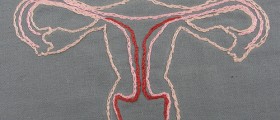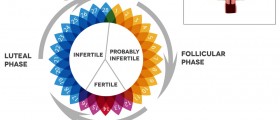
Ovarian cysts are almost never a sign of ovarian cancer. The most common kind of cyst in ovaries is the functional cyst. This kind of cyst is not caused by an imbalance in the hormones that cause polycystic ovarian disease (PCOS). PCOS is caused by too much luteinizing hormone keeping an egg that is ready for ovulation inside the ovary. Functional cysts are caused by an excess of or excessive sensitivity to follicle stimulating hormone. This hormone tells the primordial follicle it is time to grow so it can deliver the egg. A functional cyst occurs the follicle keeps on growing unchecked. A functional cyst can grow to 3 or 4 inches (80 to 100 mm) in diameter, stretching the lining of the ovary so much it turns blue. Functional cysts usually drain themselves into the bloodstream in 3 or 4 weeks.
Another kind of cyst associated with the ovaries is a corpus luteum cyst. The corpus luteum is a structure released by the ovaries after ovulation to release progesterone to prepare the lining of the uterus for the possible arrival of a fertilized egg. Sometimes this structure expands to the size of a marble or even 3 to 4 inches around. Like a functional cyst, the kind of ovarian cyst also usually drains itself in 3 or 4 weeks. Cysts can also results when the menstrus flows in reverse. Sometimes a tiny piece of the endometrial tissue that is discharged during a woman's period gets lodged inside an ovary, and grows and shrinks with the menstrual cycle. This kind of ovarian cyst is known as a chocolate cyst. Women who have these conditions, however, do not have polycystic ovaries.
Functional cysts, corpus luteum cysts, and chocolate cysts are typically singular. Multiple cysts result from a hormonal imbalance that keeps the egg from being released. Not every woman who has polycystic ovaries, however, has polycystic ovarian syndrome (PCOS). There can be multiple cysts without the acne, hair growth, and failure to ovulate that is characteristic of PCOS.
















Your thoughts on this
Loading...